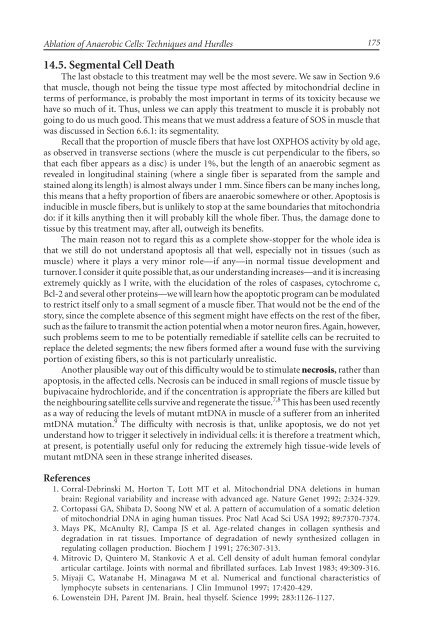The Mitochondrial Free Radical Theory of Aging - Supernova: Pliki
The Mitochondrial Free Radical Theory of Aging - Supernova: Pliki
The Mitochondrial Free Radical Theory of Aging - Supernova: Pliki
You also want an ePaper? Increase the reach of your titles
YUMPU automatically turns print PDFs into web optimized ePapers that Google loves.
Ablation <strong>of</strong> Anaerobic Cells: Techniques and Hurdles<br />
14.5. Segmental Cell Death<br />
<strong>The</strong> last obstacle to this treatment may well be the most severe. We saw in Section 9.6<br />
that muscle, though not being the tissue type most affected by mitochondrial decline in<br />
terms <strong>of</strong> performance, is probably the most important in terms <strong>of</strong> its toxicity because we<br />
have so much <strong>of</strong> it. Thus, unless we can apply this treatment to muscle it is probably not<br />
going to do us much good. This means that we must address a feature <strong>of</strong> SOS in muscle that<br />
was discussed in Section 6.6.1: its segmentality.<br />
Recall that the proportion <strong>of</strong> muscle fibers that have lost OXPHOS activity by old age,<br />
as observed in transverse sections (where the muscle is cut perpendicular to the fibers, so<br />
that each fiber appears as a disc) is under 1%, but the length <strong>of</strong> an anaerobic segment as<br />
revealed in longitudinal staining (where a single fiber is separated from the sample and<br />
stained along its length) is almost always under 1 mm. Since fibers can be many inches long,<br />
this means that a hefty proportion <strong>of</strong> fibers are anaerobic somewhere or other. Apoptosis is<br />
inducible in muscle fibers, but is unlikely to stop at the same boundaries that mitochondria<br />
do: if it kills anything then it will probably kill the whole fiber. Thus, the damage done to<br />
tissue by this treatment may, after all, outweigh its benefits.<br />
<strong>The</strong> main reason not to regard this as a complete show-stopper for the whole idea is<br />
that we still do not understand apoptosis all that well, especially not in tissues (such as<br />
muscle) where it plays a very minor role—if any—in normal tissue development and<br />
turnover. I consider it quite possible that, as our understanding increases—and it is increasing<br />
extremely quickly as I write, with the elucidation <strong>of</strong> the roles <strong>of</strong> caspases, cytochrome c,<br />
Bcl-2 and several other proteins—we will learn how the apoptotic program can be modulated<br />
to restrict itself only to a small segment <strong>of</strong> a muscle fiber. That would not be the end <strong>of</strong> the<br />
story, since the complete absence <strong>of</strong> this segment might have effects on the rest <strong>of</strong> the fiber,<br />
such as the failure to transmit the action potential when a motor neuron fires. Again, however,<br />
such problems seem to me to be potentially remediable if satellite cells can be recruited to<br />
replace the deleted segments; the new fibers formed after a wound fuse with the surviving<br />
portion <strong>of</strong> existing fibers, so this is not particularly unrealistic.<br />
Another plausible way out <strong>of</strong> this difficulty would be to stimulate necrosis, rather than<br />
apoptosis, in the affected cells. Necrosis can be induced in small regions <strong>of</strong> muscle tissue by<br />
bupivacaine hydrochloride, and if the concentration is appropriate the fibers are killed but<br />
the neighbouring satellite cells survive and regenerate the tissue. 7,8 This has been used recently<br />
as a way <strong>of</strong> reducing the levels <strong>of</strong> mutant mtDNA in muscle <strong>of</strong> a sufferer from an inherited<br />
mtDNA mutation. 9 <strong>The</strong> difficulty with necrosis is that, unlike apoptosis, we do not yet<br />
understand how to trigger it selectively in individual cells: it is therefore a treatment which,<br />
at present, is potentially useful only for reducing the extremely high tissue-wide levels <strong>of</strong><br />
mutant mtDNA seen in these strange inherited diseases.<br />
References<br />
1. Corral-Debrinski M, Horton T, Lott MT et al. <strong>Mitochondrial</strong> DNA deletions in human<br />
brain: Regional variability and increase with advanced age. Nature Genet 1992; 2:324-329.<br />
2. Cortopassi GA, Shibata D, Soong NW et al. A pattern <strong>of</strong> accumulation <strong>of</strong> a somatic deletion<br />
<strong>of</strong> mitochondrial DNA in aging human tissues. Proc Natl Acad Sci USA 1992; 89:7370-7374.<br />
3. Mays PK, McAnulty RJ, Campa JS et al. Age-related changes in collagen synthesis and<br />
degradation in rat tissues. Importance <strong>of</strong> degradation <strong>of</strong> newly synthesized collagen in<br />
regulating collagen production. Biochem J 1991; 276:307-313.<br />
4. Mitrovic D, Quintero M, Stankovic A et al. Cell density <strong>of</strong> adult human femoral condylar<br />
articular cartilage. Joints with normal and fibrillated surfaces. Lab Invest 1983; 49:309-316.<br />
5. Miyaji C, Watanabe H, Minagawa M et al. Numerical and functional characteristics <strong>of</strong><br />
lymphocyte subsets in centenarians. J Clin Immunol 1997; 17:420-429.<br />
6. Lowenstein DH, Parent JM. Brain, heal thyself. Science 1999; 283:1126-1127.<br />
175


